Application of fiber optic methods and artificial intelligence in ejaculate diagnosis in infertile males in the assisted reproductive technology programs
Objective. To establish regularities in the transmission spectrum of microstructural waveguides filled with isolated spermatozoa and seminal plasma from males with various disorders of spermatogenesis and, on this basis, to build a neural network that analyzes the spectral characteristics of sperm.Sukhikh G.T., Skibina Yu.S., Zanishevskaya A.A., Shuvalov A.A., Yanchuk N.O., Gryaznov A.Yu., Sysoeva A.P., Makarova N.P., Valiakhmetova E.Z., Kalinina E.A., Lepilin P.A.
Materials and methods. The spectral characteristics of 345 isolated spermatozoal samples and 209 seminal plasma samples were analyzed using photonic crystal waveguides as optical sensors, and an artificial neural network, the prediction accuracy of which was 100%, was built. The patients, whose ejaculate was included in the study, were also surveyed. The main parameters in the questionnaire concerned the factors influencing spermatogenesis.
Results. A neural network based on a multilayer perceptron was created, which proved to be effective in analyzing the spectral characteristics of seminal plasma and a sperm fraction. The created neural network of the ejaculate makes it possible to determine the “norm” and “pathology” with the highest accuracy. The use of artificial intelligence to analyze survey results on the male lifestyle proved to be less effective. The rate of correct answers was 88% for the test set of characteristics and 84% for the control set. Nevertheless, the developed neural network can be used for preliminary assessment and prediction of the sperm profile based on the results of a patient’s survey.
Conclusion. Fiber optic methods in the diagnosis of the ejaculate are perspective and promising. There remains an unresolved issue regarding the absence of both natural and in vitro fertilization pregnancies in the presence of normal sperm counts. The introduction of new tests for seminal plasma and spermatozoa is an urgent task of reproductive medicine; it is especially interesting to use the capabilities of artificial intelligence to assess the fertility of both men and women.
Keywords
The birth rate in developed countries has been steadily declining over the past 40 years [1]. In addition to socio-economic factors, deteriorated reproductive health of the population affects the birth rate. The World Health Organization (WHO) estimates that about 80 million couples are unable to conceive a child without medical care; 5 million of such couples live in Russia and constitute 15% of reproductive-aged population. According to the world statistics, about 40% of infertility cases are associated with the male factor [2]. Male infertility can be connected with various congenital and developed conditions: urogenital infections, genetic disorders, cryptorchidism, varicocele, hypogonadism, ejaculatory disorders, general and systemic diseases, immunological factors, unexplained infertility. Lifestyle and the influence of harmful environmental factors are also of great importance. According to the WHO report (2013) and the UN Environment Program, the production and exposure to chemicals can lead to serious disorders of the human endocrine system with a subsequent decrease in fertility [3]. For example, three large sperm banks in China reported a sharp decline in the quality of sperm from donors from cities that have been heavily polluted due to industrial growth [4].
The successful use of intracytoplasmic sperm injection into the cytoplasm of the oocyte in in vitro fertilization programs, unfortunately, changes the focus from identifying the etiology of male infertility and assessing male fertility to improving the embryological aspects of assisted reproductive technologies (ART). However, numerous clinical and scientific questions of reproductive andrology remain unanswered; in particular, there is no real progress in the development of reliable methods for sperm analysis. The basic analysis of sperm has limited value for predicting natural conception, as well as the results of assisted reproduction [5]. Men with normal spermogram indicators frequently remain infertile. Therefore, it is necessary to make testing for the functional characteristics of the ejaculate more effective. The assessment of male fertility should be a complex process including the evaluation of lifestyle, psychological state, overall health of the reproductive system, spermogram indicators and additional criteria for evaluating seminal fluid. In order to process such a large amount of clinical data and to identify patterns, it is necessary to develop analytical systems for analyzing the quality of sperm based on machine learning algorithms. A similar system was described by Abdulkerim M. (2021), but it has not been widely used yet because of its complexity [6]. It is essential to develop easy-to-use adequate methods of semen analysis and test systems, particularly for preliminary diagnosis, that should facilitate the work of laboratory personnel, speed up the analysis procedure and diagnosis, as well as allow men to monitor their health status. The most promising technical solution to the problem is the use of fiber optic sensors based on microstructural waveguides due to the analysis of small sample volumes, high accuracy and specificity [7].
A recently published paper is devoted to the use of artificial intelligence (AI) and neural networks (NN) for the preliminary assessment of sperm quality and prediction of the results of sperm analysis based on the main patient’s questionnaire [8]. This was a description of two models of NN developed on the basis of a patient’s questionnaire, which included 11 questions. One of the models is aimed at predicting the overall indicators of sperm, and the second is aimed at evaluating the concentration of sperm. The accuracy of NN in the test sample was 80.95% and 85.71%, respectively. A similar study was conducted by professor Ma J. et al. in 2018 [9]. The data on the health status and habits of 100 volunteers and their sperm tests were used to compare the effectiveness of NN with different architectures. According to the authors, backward propagation NN had the highest accuracy for determining the quality of sperm.
Thus, NN is successfully used in systems of medical diagnostics, disease prognosis, development of individual recommendations based on specific characteristics of patients and other clinical problems. However, NN and AI have not been widely used in reproductive medicine yet. In this work, we have made an attempt to use AI and fiber optic methods in the diagnosis of ejaculate parameters of men with normozoospermia, to find differences in the spectral characteristics of sperm with the same classical spermogram indicators, and to identify additional criteria for the assessment of male fertility.
The aim of this study was to determine regularities in the transmission spectrum of microstructural waveguides filled with sperm and seminal plasma of men with normozoospermia, to compare them with the data of objective control and, on this basis, to build NN.
Materials and methods
The first stage of the study identified whether NN based on a lifestyle questionnaire can be a tool for preliminary assessment and prediction of the sperm profile. The men aged from 18 to 61 years who presented to the ART department (Academician V.I. Kulakov National Medical Research Center for Obstetrics, Gynecology and Perinatology, Moscow, Russia) for performing a spermogram were eligible for inclusion in the study. We obtained the results of the analysis of 345 men undergoing routine examination due to infertility. The average age of the patients was 34.7±6 years, the average period of sexual abstinence before the test was 4.1±1 days. Sperm was evaluated using the following parameters: normozoospermia and any pathology (oligozoospermia (concentration is less than 13×106 per ml), asthenozoospermia (% of sperm motility is less than 32%) and teratozoospermia (the number of spermatozoa with normal morphology is less than 4%). The period between collecting the ejaculate and freezing the samples lasted from 15 to 60 minutes, depending on the rate of ejaculate liquefaction. The fraction of seminal plasma and spermatozoa was isolated by simple centrifugation (300g for 10 min). The samples were placed in separate Eppendorf tubes and stored at a temperature of -20oC (300 µl) before studying the spectral characteristics.
At the first stage, each of the participants filled in a questionnaire with an assessment of the following parameters (in parentheses there are the initial variables of the questionnaire and their transformation into a series of normalizations of the input data): age, coffee consumption, alcohol consumption, smoking, factors affecting spermatogenesis (hot bath, superpotent substances, radiation, work in hazardous industries), lifestyle assessment (sedentary lifestyle), concomitant chronic diseases and surgical interventions.
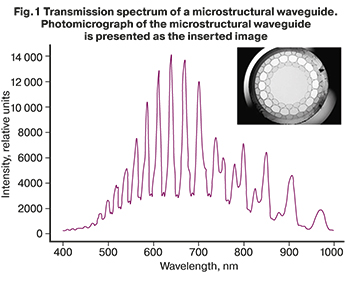 The second stage of the study included the analysis of the spectral characteristics of the sperm fraction and seminal plasma using optical sensors. Optical sensors were chosen as the most optimal, since they have high sensitivity and resolution for the detection and quantitative analysis of chemicals and biological processes. The action of these sensors is based on optical phenomena: light absorption, reflection of light, luminescence, surface plasmon resonance and photonic band gaps. Parameters of changes in the wavelength, intensity, phase, and polarization of light depending on the concentration of the identified substances and the influence of the environment on them were used as the signal of the optical biosensor [10]. Optical sensors based on microstructural hollow-core waveguides with the above-described characteristics were used in this study [11]. To measure the spectral characteristics of liquid biological samples, PdSh-type waveguides were used. The diameter of the hollow core is 180 microns, the shell consists of channels with a diameter of 17 microns and 43 microns. The transmission spectrum of an empty waveguide is shown in Figure 1.
The second stage of the study included the analysis of the spectral characteristics of the sperm fraction and seminal plasma using optical sensors. Optical sensors were chosen as the most optimal, since they have high sensitivity and resolution for the detection and quantitative analysis of chemicals and biological processes. The action of these sensors is based on optical phenomena: light absorption, reflection of light, luminescence, surface plasmon resonance and photonic band gaps. Parameters of changes in the wavelength, intensity, phase, and polarization of light depending on the concentration of the identified substances and the influence of the environment on them were used as the signal of the optical biosensor [10]. Optical sensors based on microstructural hollow-core waveguides with the above-described characteristics were used in this study [11]. To measure the spectral characteristics of liquid biological samples, PdSh-type waveguides were used. The diameter of the hollow core is 180 microns, the shell consists of channels with a diameter of 17 microns and 43 microns. The transmission spectrum of an empty waveguide is shown in Figure 1.
The samples of semen plasma were thawed at room temperature (24–26oC) for 20–30 minutes. Then 10 microns of the sample supernatant were mixed with 140 microns of water for injection. Immediately after dilution with a test sample in the amount of 30 µl, a microstructural waveguide was filled and placed in the measuring unit. The channels and the core of the waveguide were completely filled within 1–3 minutes, after which the spectrum was recorded.
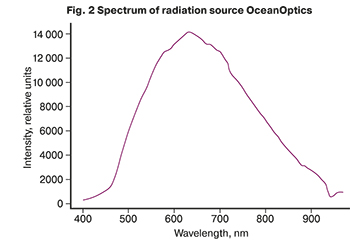 The samples with the isolated sperm fraction were also thawed at room temperature for 20–30 minutes. For injection, 30 µl of each sample were mixed with 300 µl of water for injection. Water caused hypotonic destruction of the membrane of male gametes; the DNA of spermatozoa was found in the solution. The entire sample was thoroughly mixed, homogenized, and then centrifuged at 3000 g at a rotation speed of 5000 rpm for 5 minutes. Supernatant in the volume of 30 µl was taken for each obtained sample and a microstructural waveguide placed in the measuring unit was filled with it. The waveguide channels were expected to be completely filled for 1–3 minutes, after which the radiation spectrum was recorded.
The samples with the isolated sperm fraction were also thawed at room temperature for 20–30 minutes. For injection, 30 µl of each sample were mixed with 300 µl of water for injection. Water caused hypotonic destruction of the membrane of male gametes; the DNA of spermatozoa was found in the solution. The entire sample was thoroughly mixed, homogenized, and then centrifuged at 3000 g at a rotation speed of 5000 rpm for 5 minutes. Supernatant in the volume of 30 µl was taken for each obtained sample and a microstructural waveguide placed in the measuring unit was filled with it. The waveguide channels were expected to be completely filled for 1–3 minutes, after which the radiation spectrum was recorded.
In order to construct machine learning models, the spectral characteristics of human seminal plasma and sperm samples obtained with the help of microstructural waveguides were used as input parameters. Data processing was performed in several stages. At the first stage, mathematical processing of the spectra including noise smoothing, noise removal, etc. was carried out. At the second stage, specific wavelength ranges were determined, which revealed most clearly the difference in the samples of “norm-pathology”. The OceanOptics HR 4000 spectral analyzer was used to measure the spectral characteristics. A halogen lamp was used as a radiation source, its spectrum is shown in Figure 2.
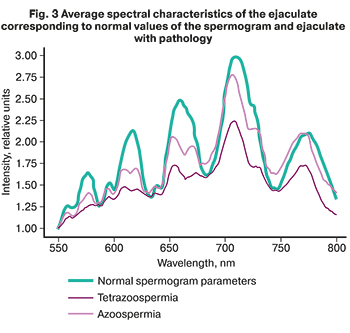 According to the results of spermogram, the samples of sperm and seminal plasma were divided into two groups: “norm” (concentration of spermatozoa is 15 mln per ml or more, sperm motility is 32% or more, number of spermatozoa with normal morphology is 4% or more) and “pathology” (any of the estimated parameters of the ejaculate and/or several parameters all at once deviate from the limits of the reference values). The division of samples is shown in Table. A total of 345 sperm samples and 209 seminal plasma samples were studied.
According to the results of spermogram, the samples of sperm and seminal plasma were divided into two groups: “norm” (concentration of spermatozoa is 15 mln per ml or more, sperm motility is 32% or more, number of spermatozoa with normal morphology is 4% or more) and “pathology” (any of the estimated parameters of the ejaculate and/or several parameters all at once deviate from the limits of the reference values). The division of samples is shown in Table. A total of 345 sperm samples and 209 seminal plasma samples were studied.
The analysis of the data is carried out using the Python 3.7 programming language, which is one of the most popular and has a significant number of machine learning libraries available.
The results of the construction of neural networks and the evaluation of ejaculate spectral characteristics
Figure 3 shows the average spectral characteristics of the ejaculate corresponding to the normal values of the spermogram and the spectral characteristics of the ejaculate with pathology, namely teratozoospermia and azoospermia.
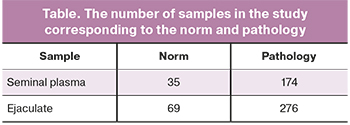
As it can be seen in Figure 3, there is a weak positive correlation for such characteristics as morphology and motility. This appeared to be enough to construct a classifier model using the k-nearest neighbors method. In relation to the test sample, the model demonstrates reliability of about 85% and 87% for the samples of seminal plasma and ejaculate, respectively. Despite the high accuracy of the method, it has its drawbacks. Spectral characteristics are used as input characteristics for each sample, and this characteristic is a one-dimensional array of data including 710 elements. Each point has an obvious impact on the predictions, and the predicted values pass through all the data points. An increase in the number of neighbors leads to producing more smoothed forecasts, but at the same time the accuracy of the approximation to the training data decreases. To process such a significant number of variables, it is worth using other machine learning methods, for example, NN to get a better result [12].
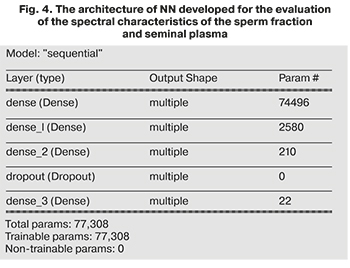 Due to the absence of clear algorithms for choosing the most optimal topology of artificial NN and their training options, these models were constructed by automated selection of the topology with the following settings: the type of NN is a multi-layer perceptron; the number of hidden layers is 4, the number of neurons in the hidden layers is 128, 20, 10, 2; the activation function of the neurons of the hidden layer is sigmoid and linear rectifier. To solve the problem of retraining, the thinning method was used. Figure 4 shows the architecture of the developed NN.
Due to the absence of clear algorithms for choosing the most optimal topology of artificial NN and their training options, these models were constructed by automated selection of the topology with the following settings: the type of NN is a multi-layer perceptron; the number of hidden layers is 4, the number of neurons in the hidden layers is 128, 20, 10, 2; the activation function of the neurons of the hidden layer is sigmoid and linear rectifier. To solve the problem of retraining, the thinning method was used. Figure 4 shows the architecture of the developed NN.
During the configuration of the NS, internal parameters were selected in such a way that the output obtained a series of values that maximally corresponded to the matrix of desired results for the training set [13, 14]. In this regard, the most common criterion for the quality of the NN was the assessment of the learning error, that is, the assessment of the difference between the desired result and the output values. In this study, root mean square error was used as a characteristic of the errors of the developed network. The share of correctly classified objects in the test sample was used as a criterion for the quality of the network operation. Both selected criteria allowed us to quantify the quality of the work of the developed NN.
 After training the developed NN using a set of spectral characteristics of training set (258 samples) and test set (87 samples), NN demonstrated 100% accuracy (Fig. 5).
After training the developed NN using a set of spectral characteristics of training set (258 samples) and test set (87 samples), NN demonstrated 100% accuracy (Fig. 5).
 It is worth noting that NN will also show 100% accuracy of forecasts if the spectral characteristics of seminal plasma samples are passed to the trained NN as input data (Fig. 6). It is indicative of a high correlation between the seminal plasma sample and the ejaculate that has undergone the necessary sample preparation, regarding the classification “norm-pathology”.
It is worth noting that NN will also show 100% accuracy of forecasts if the spectral characteristics of seminal plasma samples are passed to the trained NN as input data (Fig. 6). It is indicative of a high correlation between the seminal plasma sample and the ejaculate that has undergone the necessary sample preparation, regarding the classification “norm-pathology”.
The network developed to assess the characteristics of sperm using the basic data of the lifestyle questionnaire turned out to be less effective. The rate of correct answers was 88% for the test set of characteristics and 84% for the control set. Nevertheless, this artificial NN can be used for preliminary assessment and prediction of the sperm profile based on the results of the patient’s questionnaire.
Conclusion
This study analyzed 345 samples of ejaculate and 209 samples of seminal plasma from patients aged from 18 to 61 years with the help of constructed artificial NN, which analyzed the spectral characteristics of biological fluids. It was possible to achieve the highest accuracy in determining the fertile status of men using microstructural hollow-core waveguides and constructed NN that analyzed the obtained spectra. The use of accurate diagnostic tests, similar to the described ones, will reduce the subjective factor, depending on the operator, when evaluating a standard spermogram, and it will provide a more accurate diagnostic criterion.
It should be noted that NN will not be able to replace the standard diagnostic examination yet; AI can be a useful tool for assessing the patient’s condition while studying the fertility of a potentially infertile couple, as well as for the preliminary selection of sperm donors. However, the developed method has great prospects for the diagnosis of male infertility. Further studies in the assessment of male fertility will be aimed at constructing a comprehensive system that will include the analysis of the patient’s lifestyle, case history, spermogram and spectral characteristics of the ejaculate/seminal plasma.
References
- GBD 2017 Population and Fertility Collaborators. Population and fertility by age and sex for 195 countries and territories, 1950-2017: a systematic analysis for the Global Burden of Disease Study 2017. Lancet. 2018; 392(10159): 1995-2051. https://dx.doi.org/10.1016/S0140-6736(18)32278-5.
- Rumbold A.R., Sevoyan A., Oswald T.K., Fernandez R.C., Davies M.J., Moore V.M. Impact of male factor infertility on offspring health and development. Fertil. Steril. 2019; 111(6): 1047-53. https://dx.doi.org/10.1016/j.fertnstert.2019.05.006.
- WHO, UNEP. State of the science of endocrine disrupting chemicals 2012: an assessment of the state of the science of endocrine disruptors prepared by a group of experts for the United Nations Environment Program and World Health Organization. Geneva: WHO; 2013.
- Huang C., Li B., Xu K., Liu D., Hu J., Yang Y. et al. Decline in semen quality among 30,636 young Chinese men from 2001 to 2015. Fertil. Steril. 2017; 107(1): 83-8. e2. https://dx.doi.org/10.1016/j.fertnstert.2016.09.035.
- Ефремов Е.А., Касатонова Е.В., Мельник Я.И., Никушина А.А. Почему не обновляются рекомендации по исследованию эякулята? Урология. 2019; 4: 148-54. [Efremov E.A., Kasatonova E.V., Melnik Ya.I., Nikushina A.A. Why are recommendations on the study of ejaculate not updated? Urology. 2019: 4: 148-54. (in Russian)]. https://dx.doi.org/10.18565/urology.2019.4.148-154.
- Yibre A.M., Koçer B. Semen quality predictive model using Feed Forwarded Neural Networktrained by Learning-Based Artificial Algae Algorithm. Engineering Science and Technology: An International Journal (JESTECH). 2021; 24(2): 310-8. https://dx.doi.org/10.1016/j.jestch.2020.09.001.
- Тучин В.В. Лазеры и волоконная оптика в биомедицинских исследованиях. 2-е изд. М.: ФИЗМАТЛИТ; 2010. 488 с. [Tuchin V.V. Lasers and fiber optics in biomedical research. 2nd ed., correct and additional. M.: FIZMATLIT; 2010. 488 p. (in Russian)]. ISBN 978-5-9221-1278-9.
- Badura A., Marzec-Wróblewska U., Kamiński P., Łakota P., Ludwikowski G., Szymański M., Buciński A. Prediction of semen quality using artificial neural network. J. Appl. Biomed. 2019; 17(5): 167-74. https://dx.doi.org/10.32725/jab.2019.015.
- Ma J., Zhen A., Guan S.U., Liu C., Huang X. Predicting seminal quality using back-propagation neural networks with optimal feature subsets. In: Advances in Brain Inspired Cognitive Systems: 9th International Conference, BICS 2018. Xi'an, China, July 7-8, 2018, Proceedings. 2018: 25-33. https://dx.doi.org/10.1007/978-3-030-00563-4_3.
- Малинин А.В., Скибина Ю.С., Тучин В.В., Чайников М.В., Белоглазов В.И., Силохин И.Ю., Занишевская А.А., Дубровский В.А., Долмашкин А.А. Применение фотонно-кристаллических волноводов с полой сердцевиной в качестве биологических сенсоров. Квантовая электроника. 2011; 41(4): 302-7. [Malinin A.V., Skibina Yu.S., Tuchin V.V., Chaynikov M.V., Beloglazov V.I., Silokhin I.Yu., Zanishevskaya A.A., Dubrovsky V.A., Dolmashkin A.A. Application of photonic-crystalline waveguides with hollow core. Quantum electronics. 2011; 41(4): 302 (in Russian)].
- Zanishevskaya A.A., Malinin A.V., Tuchin V.V., Skibina Y.S., Silokhin I.Y. Photonic crystal waveguide biosensor. J. Innov. Opt. Health Sci. 2013; 6(2): 1350008. https://dx.doi.org/10.1142/S1793545813500089.
- Мюллер А., Гвидо С. Введение в машинное обучение с помощью Python. Руководство для специалистов по работе с данными. СПб.: Альфа-книга; 2017. [Muller A., Guido C. Introduction to machine learning with Python. Data Specialist Guide. St. Petersburg: Alfa-Book LLC. 2017. (in Russian)].
- Грибачев В. Настоящее и будущее нейронных сетей. Компоненты и технологии. 2006; 5: 146-50. [Gribachev V. The present and future of neural networks. Components and technologies. 2006; 5: 146-50 (in Russian)].
- Krizhevsky A., Sutskever I., Hinton G.E. Imagenet classification with deep convolutional neural networks. In: Bartlett P.L., Pereira F.C.N., Burges C.J.C., Bottou L., Weinberger K.Q., eds. Advances in Neural Information Processing Systems 25: 26th Annual Conference on Neural Information Processing Systems 2012. Proceedings of a meeting held, Lake Tahoe, Nevada, United States, 2012, 3-6 December. 2012: 1106-14.
Received 12.04.2021
Accepted 18.06.2021
About the Authors
Gennady T. Sukhih, M.D., Ph.D., Professor, Director of V.I. Kulakov NMRC for OG&P, Ministry of Health of Russia. E-mail: g_sukhikh@oparina4.ru.117997, Russia, Moscow, Oparin str., 4.
Julia S. Skibina, Ph.D. in physics and mathematics, Director of LLC SPE “Nanostructed Glass Technology”, Deputy Director of International Research and Education Center “Structural Nanobiophotonics”. E-mail: director@nano-glass.ru. 410033, Russia, Saratov, pr. 50 let Octyabrya, 101, room III (PO Box 2985).
Anastasia A. Zanishevskaya, Senior Research Fellow, LLC SPE “Nanostructed Glass Technology”, Head of the Advanced Research Department of International Research and Education Center “Structural Nanobiophotonics”. E-mail: zanishevskayaaa@nano-glass.ru. 410033, Russia, Saratov, pr. 50 let Octyabrya, 101, room III (PO Box 2985).
Andrey A. Shuvalov, Deputy Head of Research Department, LLC SPE “Nanostructed Glass Technology”, International Research and Education Center “Structural Nanobiophotonics”. E-mail: shuvalovaa@nano-glass.ru. 410033, Russia, Saratov, pr. 50 let Octyabrya, 101, room III (PO Box 2985).
Natalia O. Yanchuk, Ph.D. in medical sciences, Head of the Sensor Technology Department in International Research and Education Center “Structural Nanobiophotonics”. E-mail: info@nano-glass.ru. 410033, Russia, Saratov, pr. 50 let Octyabrya, 101, room III (PO Box 2985).
Aleksey Yu. Gryaznov, Leading Researcher, LLC SPE “Nanostructed Glass Technology”, Head of the Department of Decision Support Systems in International Research and Education Center “Structural Nanobiophotonics”. E-mail: info@nano-glass.ru 410033, Russia, Saratov, pr. 50 let Octyabrya, 101, room III (PO Box 2985).
Anastasia P. Sysoeva, Embryologist of ART Department, V.I. Kulakov NMRC for OG&P, Ministry of Health of Russia.
E-mail: sysoeva.a.p@gmail.com. 117997, Russia, Moscow, Ac. Oparina str., 4.
Nataliya P. Makarova, Ph.D., Researcher of ART Department, V.I. Kulakov NMRC for OG&P, Ministry of Health of Russia.
E-mail: np_makarova@oparina4.ru. 117997, Russia, Moscow, Ac. Oparina str., 4.
Elvira Z. Valiakhmetova, postgraduate student at the ART Department, V.I. Kulakov NMRC for OG&P, Ministry of Health of Russia.
E-mail: ibraeva1988@list.ru. 117997, Russia, Moscow, Ac. Oparina str., 4.
Elena A. Kalinina, M.D., Ph.D., Head of ART Department, V.I. Kulakov NMRC for OG&P, Ministry of Health of Russia.
E-mail: e_kalinina@oparina4.ru. 117997, Russia, Moscow, Ac. Oparina str., 4.
Pavel A. Lepilin, Researcher, LLC SPE “Nanostructed Glass Technology”. E-mail: info@nano-glass.ru. 410033, Russia, Saratov, pr. 50 let Octyabrya, 101, room III (PO Box 2985).
For citation: Sukhikh G.T., Skibina Yu.S., Zanishevskaya A.A., Shuvalov A.A., Yanchuk N.O., Gryaznov A.Yu., Sysoeva A.P., Makarova N.P., Valiakhmetova E.Z., Kalinina E.A., Lepilin P.A. Application of fiber optic methods and artificial intelligence in ejaculate diagnosis in infertile males in the assisted reproductive technology programs.
Akusherstvo i Ginekologiya/Obstetrics and Gynecology. 2021; 7: 74-80 (in Russian)
https://dx.doi.org/10.18565/aig.2021.7.74-80



